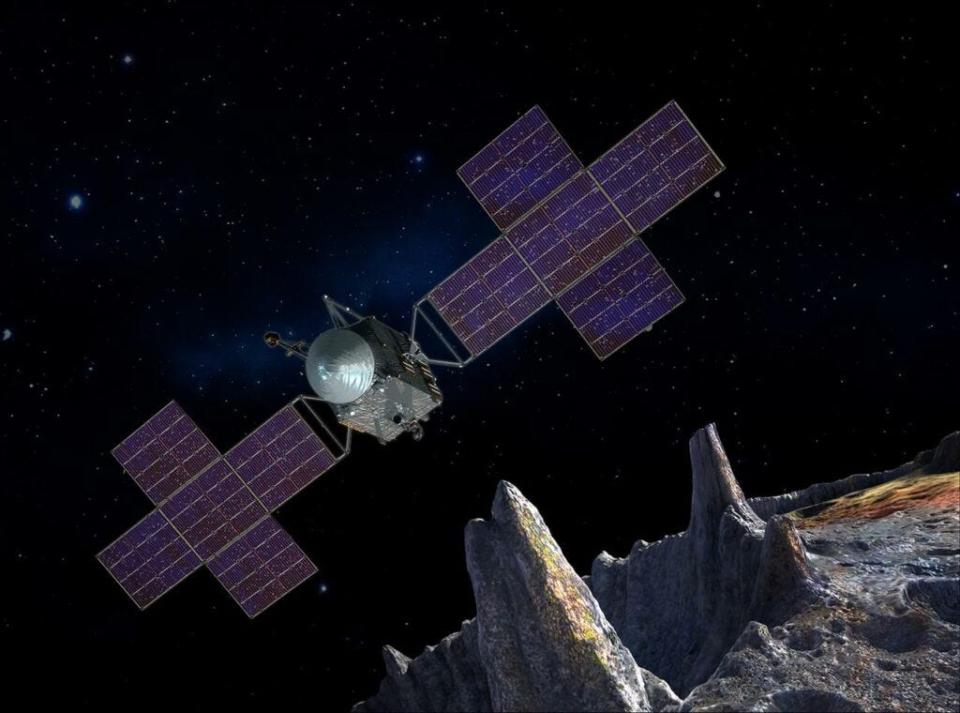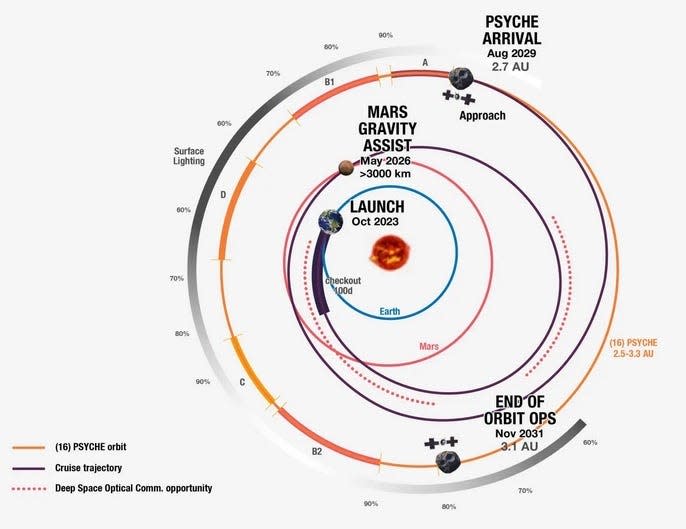Public invited to explore Psyche space mission at AAE school in Apple Valley
NASA/Jet Propulsion Laboratory will help the Lewis Center for Educational Research in Apple Valley to host a unique cosmic presentation.
On Thursday, the public is invited to the Academy for Academic Excellence’s multipurpose room, where members of the Psyche Flight Team will share details about NASA's Psyche Mission. Psyche is a NASA-based space mission to study a metal-rich asteroid with the same name, located in the main asteroid belt between Mars and Jupiter.
The team will guide visitors through the details and pioneering insights that drive the NASA mission. They will unravel the mysteries of the unique asteroid, providing key clues to the formation of the solar system.
This presentation will take place at 4 p.m. in the Academy for Academic Excellence multipurpose room at 17500 Mana Road in Apple Valley. To register, email jcorona@lcer.org or visit facebook.com/LewisCenterED.

The launch
Psyche, which is NASA's first mission to study an asteroid that has more metal than rock or ice, was launched Oct. 13 from the Kennedy Space Center in Florida.
Psyche lifted off aboard a SpaceX Falcon Heavy rocket. Psyche is the first in a series of NASA science missions to be the primary payloads launched on a SpaceX Falcon Heavy rocket.
“Now the real fun begins, as we race toward asteroid Psyche to unlock the secrets of how planets form and evolve,” said Laurie Leshin, director of NASA’s JPLin Southern California, which is responsible for the mission’s overall management, system engineering, integration and test, and mission operations.
Nicola Fox, associate administrator for the Science Mission Directorate at NASA Headquarters in Washington, D.C. said by studying asteroid Psyche, they hope to better understand the universe and mankind’s place in it, especially regarding the mysterious and impossible-to-reach metal core of planet Earth.
A date with an asteroid
Asteroid Psyche’s gravity will capture the spacecraft in late July 2029, and Psyche will begin its prime mission in August. It will spend about two years orbiting the asteroid to take pictures, map the surface, and collect data to determine Psyche’s composition.
The body of the Psyche spacecraft is about the size of a small van, and it’s powered by solar electric propulsion. It has a magnetometer, a gamma-ray and neutron spectrometer, and a multispectral imager to study asteroid Psyche.
The spacecraft will start sending images to Earth as soon as it spots the asteroid.
Scientists think asteroid Psyche, which is about 173 miles at its widest point, could be part or all of the iron-rich core of a planetesimal, a building block of a rocky planet.

About Psyche
Psyche was discovered in 1852 by Italian astronomer Annibale de Gasparis. Because it was the 16th asteroid to be discovered, it is sometimes referred to as 16 Psyche. It’s named for the goddess of the soul in ancient Greek mythology, often depicted as a butterfly-winged female figure, according to NASA
Psyche orbits the Sun in the outer part of the main asteroid belt between Mars and Jupiter. It is approximately three times farther from the sun than Earth. Because Psyche and Earth orbit at different speeds, the distance from Earth to Psyche varies from less than 186 million miles to more than 372 million miles.
Psyche is irregular and potato-like. If the asteroid were sliced in half horizontally at the equator – picture a squashed oval – it would measure 173 miles across at its widest point and 144 miles long. Its surface area is 64,000 square miles.
Rock and heavy metal
Psyche is dense, estimated at about 212 to 256 pounds per cubic foot. The surface gravity on Psyche is much less than it is on Earth – even less than it is on Earth’s Moon.
On Psyche, lifting a car would feel like lifting a large dog.
Scientists think Psyche may consist of significant amounts of metal from the core of a planetesimal, one of the building blocks of our solar system. The asteroid is most likely a survivor of multiple violent hit-and-run collisions, common when the solar system was forming.
There are still contradictions in the data, but scientific analysis indicates that Psyche is likely made of a mixture of rock and metal, with metal composing 30% to 60% of its volume.
Daily Press reporter Rene Ray De La Cruz may be reached at 760-951-6227 or RDeLaCruz@VVDailyPress.com. Follow him on Twitter @DP_ReneDeLaCruz
This article originally appeared on Victorville Daily Press: Public invited to explore Psyche space mission at AAE in Apple Valley

